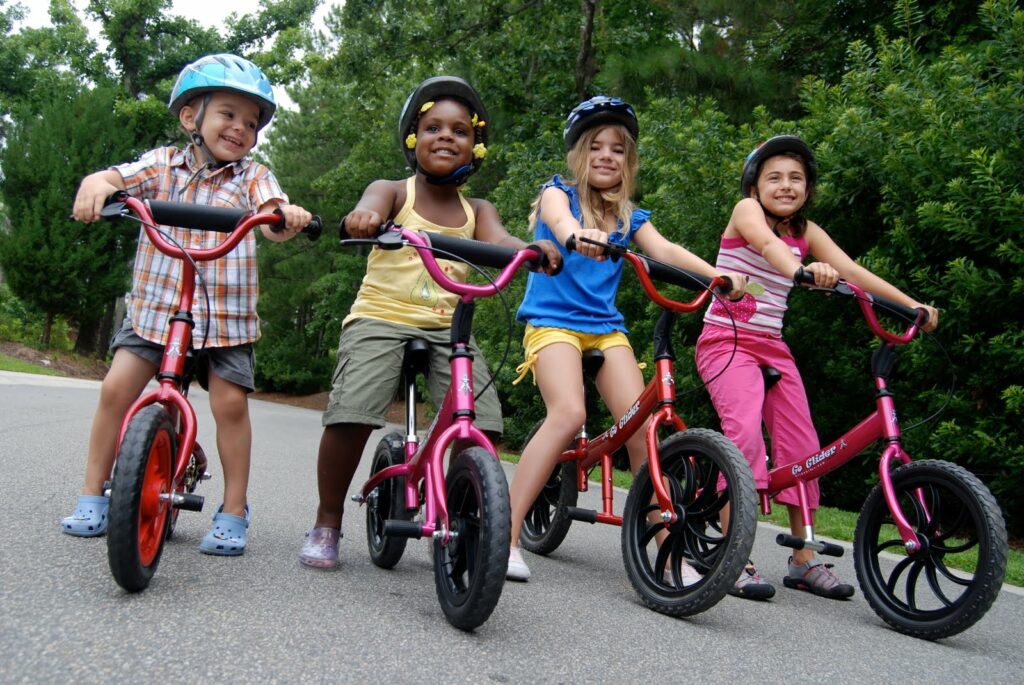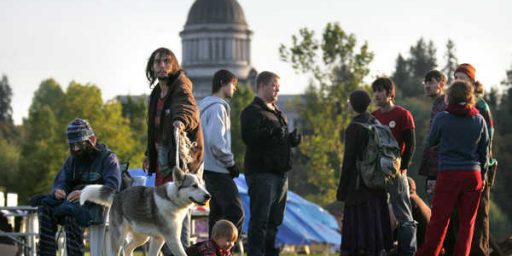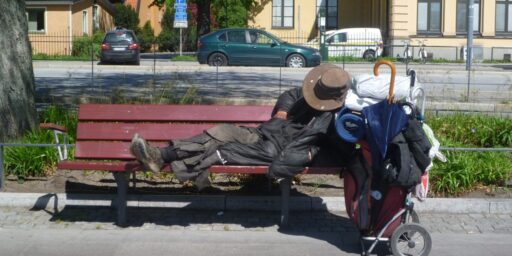Are Helmet Laws Racist?
Surprisingly, yes.

NYT/Yahoo (“Seattle Bike Helmet Rule Is Dropped Amid Racial Justice Concerns“):
In Seattle, home to one of the largest populations of bike commuters in the country, officials have overturned a decades-old regulation requiring cyclists to wear helmets because of discriminatory enforcement of the rule against homeless people and people of color.
The King County Board of Health voted to repeal the requirement Thursday, with only one member opposing the decision to roll back a measure that even critics acknowledge has saved lives.
“The question before us yesterday wasn’t the efficacy of helmets,” said Girmay Zahilay, a board member who is also a member of the King County Council. “The question before us was whether a helmet law that’s enforced by police on balance produces results that outweigh the harm that that law creates.”
At first blush, this seems silly. How can a requirement to wear safety gear have such a disparate impact? I mean, how many homeless people even have bicycles?
The health board, made up of elected officials and appointed medical experts from across the county, began to scrutinize the helmet rule in 2020 after an analysis of court records from Crosscut, a local news site, showed that it was rarely enforced, and enforced disproportionately when it was. Since 2017, Seattle police had given 117 helmet citations, more than 40% of which went to people who were homeless. Since 2019, 60% of citations went to people who were homeless.
A separate analysis from Central Seattle Greenways, a safe streets advocacy group, found that Black cyclists were almost four times as likely to receive a citation for violating the helmet requirement as white cyclists. Native American cyclists were just more than twice as likely to receive one as white cyclists.
Seattle proper has 724,305 residents, roughly 70% of whom are white, 8% are Black, and less than 1% are Amerindian. What percentage of them are bicycle riders, I haven’t a clue. But the key here seems to be that the law is essentially never enforced—at least at the level of citation—and when it is, it’s incredibly disproportional.
Still, the obvious solution would seem to be better training and supervision. It’s well into the report before the issue is finally clear:
Neither study looked at whether homeless people or people of color wore helmets less frequently than other groups — or whether, out of economic necessity, they were more likely to ride a bike. Critics nonetheless said enforcement appeared to be discriminatory.
“It was a law that really just allowed the Police Department, the Seattle Police Department, to harass Black and brown community members,” said KL Shannon, an organizer for Seattle Neighborhood Greenways and police accountability chair for the Seattle King County chapter of the NAACP.
Shannon’s nephew was 8 years old when he and three friends were stopped by an officer a few blocks from their houses for not wearing helmets, Shannon said. She said the officer accused them of stealing the bikes.
“Until this day my nephew doesn’t ride a bike,” Shannon said. “He’s never forgotten that.”
In an incident in 2016, a Black man was stopped by Seattle police for riding a bike with no helmet. In a dashcam video of the tense, 19-minute stop, one officer shared with another that the man “matches the description of a burglary suspect,” suggesting that the helmet regulation was used as a pretense.
In 2019, Daniel Oakes was stopped for not wearing his helmet while riding his bicycle on a sidewalk near a homeless encampment and then charged with an unrelated offense. A judge dismissed the case after Oakes’ lawyer argued that the helmet requirement had been unconstitutionally used as a pretext to make the stop.
Let’s stipulate that this is extremely anecdotal. But it certainly makes sense: there’s a rarely-enforced law on the books. If police see a white kid in an affluent neighborhood riding without a helmet, they’ll either ignore it or give a friendly warning about safety. If they see a Black or Amerindian kid in a poor neighborhood—or, hell, in a rich neighborhood—riding without a helmet, they’ll assume the bike was stolen. And any pretext to harass the homeless will do.
This is an example of institutional racism. The law was passed with good intention with no thought at all to harming the disadvantaged. It’s facially neutral as to race and socioeconomic status. And yet its impact is wildly different across groups in ways that are predictable, if perhaps only in hindsight.
_________________________
As a tangentially related aside: it’s astonishingly difficult to find stock photos of non-white people riding a bicycle. All of the ones at pXHere, which is my go-to for free, unrestricted photos, feature whites






It’s telling that the only remedy the board could come up with to address police harassing citizens in a racist way was to reverse the law that gave them pretext.
I realize the King County Board of Health is a County-level organization with minimal power trying to address things going on within a city-led institution, but one assumes there is some sort of coordination between county and city agencies, given that Seattle comprises a huge percentage of King County’s population.
Public safety laws like this are always going to provide excuses for discriminatory enforcement. The solution is not to get rid of public safety, rather it is to get rid of the criminals who use the badge they wear to enforce personal vendettas.
Sort of related: Sikhs in the UK are exempt from laws requiring wearing of motorcycle helmets.
(Only “sort of” because Sikhs are not a “race”; and non-practicing Sikhs are required to wear helmets. Exactly how “practicing” would be determined in, errmm, practice, has never been adjudicated AFAIK.)
@JohnSF:
They don’t cut their hair, I have seen sikh boys with their hair in a bun, no turban. Presumably hard to wear a helmet.
The vet I used in Kuala Lumpur was a sikh, but he did not wear a turban, nothing special about his hair.
I find it a bit surprising that Washington doesn’t have a statewide helmet rule.
@charon:
Oh, that I know.
At work there are two practicing and three (I think) non-practicing Sikhs in our office area.
About 5% of the population of Birmingham are Sikhs.
But some non-practicing Sikhs wear a turban; the hair in a bun style is (generally) for children regarded as too young to commit to the faith (customs vary on this).
And some (not many) non-Sikh south Asians wear turbans; sufis, shia, Rajputs, some Hindu monks and sivaists.
The pragmatic rule of the police, I suspect, is “if wearing a turban, don’t bother”.
So a law with no racist or classist intent ends up being enforced in a racist and classist way. Given how the police work, this sort of thing seems to be sort of built into the structure of our society. Maybe law schools should have some sort of theory for critically examining such things.
Another observation: helmet wearing on bicycles (as opposed to motorcycles) is not a legal requirement in the UK, but it’s pretty much universal anyway.
However, in Belgium and the Netherlands where bicycle use is far higher than in Britain, helmets are very rarely worn.
Less than 1% I think the figures are; certainly last time I was in Belgium, I can’t recall seeing a single cyclist wearing one, apart from a few small children.
I think the Board of Health acted correctly. The vast number of laws, however well-intentioned, without good faith attempts at enforcement, is tyrannical. Enforcement will inevitably be against people the law enforcement officers don’t like, think are up to something, shouldn’t be there, etc.
I think the solution is fewer laws. Alternatively, the solution could be a lot more enforcement with penalties against law enforcement officers who fail to enforce the law. Each of those positions bears risks.
I bike a lot and normally wear a helmet, it’s good for keeping the AZ sun off.
Except in really cold weather, when wearing something warmer takes priority.
Not in Texas or Tennessee, that is the very basis of CRT and we don’t have any of that in those states.
Of course.
@JohnSF:
I expect in Britain riding is mainly recreation and exercise, in the Netherlands it’s how people get to work.
@charon:
That’s the case, certainly.
The figures are about 6% commute by bicycle in UK, which is about the same as Portland.
By comparison around a third of commuting in the Netherlands is by bike (rising to about 60% IIRC in Amsterdam; “only” 25% in Rotterdam).
Likely if you are less exposed to motor traffic when cycling, you worry less about accidents?
And it’s more a case “hop-on and go” as a matter of course.
Apparently winter sports can be quite dangerous.
Goddam it, wrong thread. Sorry.
Is it possible that police patrol minority neighborhoods because crime stats are higher there? Ever read about the “broken window” theory that greatly reduced crime in NYC? Washington state has a helmet law for motorcyclists. Do they excuse some bikers if they’re black or brown?
Joyner-the older you get the more foolish you become.
@John430: Yes, we’ve all heard of “broken windows” policing, for which see @gVOR08: above.
@John430:
As mentioned, we do in Britain. (Sort of)
Have done for some forty five years.
As yet, rule of law has failed to collapse.
*taps watch*
@JohnSF: “Less than 1% I think the figures are; certainly last time I was in Belgium, I can’t recall seeing a single cyclist wearing one, apart from a few small children.”
My observation from spending time in the Netherlands is that this is because is substantially safer to ride a bike there because bikes have the right of way, unlike in car-obsessed countries where cyclists are considered an obstacle or even a target.
In that Photo, only 1 out of 4 kids is wearing their helmet correctly, it should cover part of the forehead.
Bike helmets are very rare in the Netherlands, but there are other stringently enforced bicycle safety rules such as lights and right of way. Do not ride a bike on the pedestrian side walk!
It is not at all surprising that bike helmet laws are enforced along racial and class lines in the US. I agree with the panel to get rid of the law. Prove consistent, fair, and useful results first before giving police any power.
@gVOR08: 😀
Laws are not racist. They are inanimate and lack the volition to act in any manner whatsoever. Governments are racist. Legislatures are racist. Police are racist. People are racist. Let’s keep things straight.
@John430: How A Theory Of Crime And Policing Was Born, And Went Terribly Wrong.
Perhaps a little more reading is in order.
I would add, “broken window” theory appears not to do much about crime, but it does give you outcomes like Eric Garner and George Floyd.
One more quote from the linked piece that I should have included above:
I’m not so sure that this law is institutional racism.
When I saw the headline on my RSS reader, I thought it was going to come down to Black hairstyles, Sikh turbans, and other minority head accoutrements interfering with the helmets, and that would have been institutional racism — the law, which on its face seems neutral, causes disproportionate impact even when enforced consistently.
This is just plain non-institutional racism. This is cops harassing minorities because they can. This is Seattle Police being racist shitheads.
No fancy Critical Race Theory is required to understand that the stereotypical Southern Sheriff telling Black people to get out of town before sundown is just racist shit, and that’s basically what this is.
Rolling back this law does nothing to solve that problem. If we rolled back every law which was being enforced in a racist manner, I don’t think we would have many laws left.
@Gustopher:
I would disagree in the sense that what we are seeing here is exactly what CRT suggests is the case: that laws that are, on their face, race-neutral nonetheless become tools of racist outcomes.
It doesn’t take a stereotypical southern sheriff type to have a law like this lead to disproportionately racist outcomes. It just takes a view, like john430’s above, that minority neighborhoods are a problem and then giving police a tool that seems reasonable (bicycle safety) to enforce.
@Gustopher:
@Steven L. Taylor:
The law is not enforced in white neighborhoods because it is an unnecessary (thus bad) law.
No one is at risk apart from the cyclist. Head injuries from spills are pretty improbable, the traditional cycling injury is fractured clavicle. Or, perhaps, an arm or shoulder fracture. So the only real risk is an encounter with an auto.
@JohnSF: When I went to Osaka for a visa run once, I needed to stay for 3 days for the visa to finish processing and, as is my wont, spend a couple of days walking touring the city. One of my pictures is of a roughly 2 or 300 stall bicycle parking lot–filled with bikes as it was midday and in a mixed residential/office zone.
@John430: Do you ever get tired of saying really relentlessly stupid things? That one wasn’t just down in the dirt, it didn’t even get off the mound. If you’d dropped it, it would have gone further toward home plate.d
But keep pitching. The more you throw, the better you’ll become (or get bursitis–whichever will happen first).
@John430:
You are conflating separate issues here. This is not about there being more policing in black neighborhoods than white. This is about police not enforcing the same law when they are already present in white neighborhoods as they do in black. And, really, not even that – it’s about making cycling while black illegal in the same way driving while black is.
I think a deeper dive into the context of these citations would reveal something very different than, “Oh look, a black guy without a helmet! Let’s ticket him!”, by the police. I don’t doubt that there are some genuinely racists cops in Seattle, but I suspect there is much more to this story.
For example, how many of the homeless people given a helmet citation were also cited for other infractions at the same time and/or were stopped for other infractions? I myself live in a city with a substantial homeless problem and, indeed, a disproportionate number of these homeless individuals are people of color. A great many of them have bicycles.
Anecdotal, but I can tell you that when I see someone engaging in extremely reckless cycling in the city, the sort of behavior that would compel a police officer to actually do something, the odds of them being someone who appears to be homeless/indigent is very, very high.
“Disparate impact” does not always equal racist enforcement.
@Steven L. Taylor: I always thought the systemic, institutional racism that CRT was concerned with was the stuff that created discriminatory effects, and baked in past racism, without anyone having to be racist.
Here (Seattle) the police are really racist (just one step short of openly racist on a good day), so their putting their fingers on the scale.
Goes to show that almost no one knows what CRT is.
@charon: If cyclists were content to just lie in the gutter and die from their head injuries, and were then picked up with the rest of the trash on garbage day, and no one made a big fuss about their dead son/wife/cousin/son-wife-cousin, then I would agree with you.
Helmets for bicyclists are like seatbelts for cars — fewer dead people is generally a community good.
@Gustopher:
Depends on the situation, and local “custom”.
Low Countries are pretty big on community goods, but bike helmets? Nah.
@JohnSF:
Not quite sure how you got from disparate policing enforcement (to all appearances based on race/economic status) to local custom. As Cracker noted, you’re not getting anywhere near home plate. Maybe we ought to move the mound closer for you.
Unless, of course, the “local customs” you’re in support of include redlining, “tuning up” minorities (especially the uppity ones), and similar behaviors.
@John430:
There is actually no evidence that broken window theory had any substantive impact on crime in NYC. The rates in NYC feel at more or less the same rate as the rest of the US during the same period.
Example, but not the only source:
https://news.northeastern.edu/2019/05/15/northeastern-university-researchers-find-little-evidence-for-broken-windows-theory-say-neighborhood-disorder-doesnt-cause-crime/
@Flat Earth Luddite:
Um?
May be at cross-purposes here.
I was referring not to discriminatory law enforcement, but off at a tangent (sorry).
Ref. to Gustopher about cyclists wearing safety helmets.
There is no law requiring them to be worn in UK, but “custom” (for want of a better word: convention? practice?) is that they are almost universally worn, and many people, especially cyclists, are very disapproving of those who do not.
Whereas in Netherlands and Belgium, where bicycle use is much higher, helmet use is pretty rare.
While in some parts of the US bicycle helmets are a legal requirement.
Just an example of the variation of laws and custom between socities, which is always something that intrigues me.
A lot of people tend to take their laws/customs for granted, and can be a bit surprised when other societies take a different view.
Hardly a Earth shaking novel observation on my part, but interesting. To me.
YMMV.
@Flat Earth Luddite:
And that sort of, kind of, related to my earlier reference to UK law that Sikhs have an exemption from the requirement to wear helmets on motorcycles.
@Flat Earth Luddite: No, I was talking about John 430. My take on JohnSF’s comment was that racism of the sort we’re seeing in Seattle isn’t exclusive to the US. But that’s outside my bailiwick.
@Just nutha ignint cracker:
@JohnSF:
Sorry, guys, I was trying to comment/respond/rant @John430, not @JohnSF. This may be why I refer to almost everyone I talk to as “Kiddo” or “Dude.” Names have become way too tough for Luddite.
As previously noted, Dyslexic Luddite Muffin here, and obviously I need to spend more time on my reading/editing skills, and less time on ranting. Pardon me everyone while I slink back into my cave…
@Flat Earth Luddite:
No worries.
A plethora of Johns can present a problem (until recently there were four of that ilk in our department at work; we tended to get called by initials or by surname).
Bicycle chop chops. Your $4K bike is now as spray painted – beause a $4 k bike needs to be spray painted. bikeinsex.com
“The question before us yesterday wasn’t the efficacy of helmets,” said Girmay Zahilay……….
Which is a pity, because if they did bother to examine the efficacy of helmets, they would have withdrawn the law many years ago. The death rate of cyclists, the only reliable metric, does not fall as helmet wearing rates increase, despite the thousands of erroneous “helmet saved my life” stories.
Helmets are a useful way for drivers to blame their victims and avoid responsibility, and are an environmental disaster, but they are an excellent example of disaster capitalism; make people afraid of something by grossly exaggerating the risks, then sell them a plastic hat which makes them feel safer, even if they aren’t.
@Richard Burton:
Correlation is not causation.
Logical fallacy. Confounding factors?
Reminds me of NM, we had a number of bad accidents with kids riding in the backs of pickup trucks being thrown off and killed. So they introduced a law requiring restraining devices in the back of pickups if people were to ride in them. Was ultimately killed because it would predominantly affect rural Hispanics and Native Americans, and therefore racist.
@Richard Burton:
I was riding on city streets at a high rate of speed and made a left turn without slowing . My wheel hit some oil or something and kicked out from under me and I went airborne, and came down on my left hip, then my head whipped into the asphalt. I was wearing a helmet which I only wore while I was riding hard. My first thought as I lay there was ” I cannot believe I am still conscious. ” My hip was badly bruised, but my head was fine. After I hobbled to the sidewalk, my wheel collapsed by the crash, I stood there contemplating how I would get home. The light changed and the cross traffic started to move. The crash was SO bad that two of the cars that had been stopped and saw the crash stopped to see if I was OK.
I am convinced that my brains would have been all over the street ( ok , a little over dramatic) if I were not wearing a helmet. Now I wear one even on casual rides.